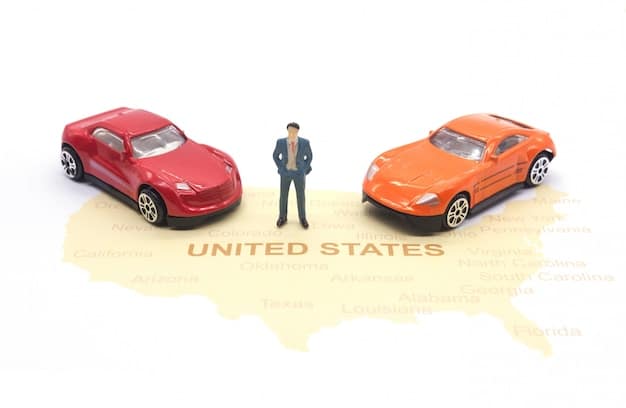Ride-Sharing Impact: Analyzing Car Ownership Trends in the US

Analyzing the Impact of the Increasing Popularity of Ride-Sharing Services on Car Ownership in the US reveals a complex interplay between convenience, cost, and urban lifestyles, potentially leading to a decrease in personal vehicle dependence among certain demographics.
Have you ever wondered if the rise of Uber and Lyft is changing our relationship with cars? The increasing popularity of ride-sharing services is undoubtedly impacting car ownership in the US, and we’re here to dive deep into the trends, data, and potential future of transportation.
The Rise of Ride-Sharing: A Transportation Revolution
Ride-sharing services have exploded in popularity over the last decade, transforming how people move around cities and beyond. This convenient and often cost-effective alternative to traditional transportation is reshaping urban landscapes and influencing personal transportation choices.
But what exactly are the key factors driving this ride-sharing revolution?
Convenience and Accessibility
Ride-sharing apps offer unparalleled convenience. With a few taps on your smartphone, you can summon a ride to your exact location, eliminating the need to wait for a taxi or navigate public transport schedules. This ease of use is particularly attractive in densely populated urban areas.
Cost Considerations
For many individuals, the overall cost of car ownership—including loan payments, insurance, maintenance, and fuel—can be substantial. Ride-sharing provides a pay-as-you-go alternative, potentially saving money for those who only need occasional transportation.
- Comparing the costs of ride-sharing versus car ownership often depends on individual usage patterns and location.
- Ride-sharing can be more economical for infrequent users who primarily travel short distances.
- However, frequent riders may find that car ownership remains the more cost-effective option in the long run.
The convenience and potential cost savings associated with ride-sharing are attracting new users every day and will continue to increase over time.
Understanding Car Ownership Trends in the US
To fully grasp the impact of ride-sharing, it’s crucial to understand existing car ownership trends in the United States. While the US has long been a car-centric nation, recent data suggests a possible shift in attitudes and behaviors.
Let’s explore some of the key factors influencing these trends.

Demographic Shifts
Different generations view car ownership differently. Millennials and Gen Z are often more open to alternative transportation options, including ride-sharing and public transit, compared to older generations who grew up during the heyday of car culture.
Urbanization
As more people move to cities, parking becomes scarcer and more expensive, and traffic congestion worsens. In these environments, the appeal of owning a car diminishes, making ride-sharing a more attractive option.
- Urban residents often have access to a wider range of transportation alternatives, including public transit, bike-sharing programs, and pedestrian-friendly infrastructure.
- The density of urban environments makes ride-sharing services readily available and efficient.
- Limited parking and high parking costs in cities can make car ownership a financial burden.
Understanding how our demographics shift and urbanization increases is essential when understanding the impact and influence of ride-sharing in relation to vehicle ownership.
Analyzing the Correlation between Ride-Sharing and Car Sales
The relationship between the increasing popularity of ride-sharing services and car sales figures is an area of ongoing debate. While it’s difficult to establish a direct causal link, there are indications that ride-sharing is influencing purchasing decisions.
How are ride-sharing trends correlating to car sales across the US?
Potential Impact on New Car Purchases
Some analysts suggest that ride-sharing may be contributing to a slowdown in new car sales, particularly among younger demographics. If individuals can readily access transportation on demand, they may be less inclined to invest in car ownership.
Increase in Used Car Purchases
On the other hand, ride-sharing has caused a rise in used car sales as families look to purchase reliable vehicles at a much lower cost. As used car sales increase significantly, dealerships are having difficulty maintaining supply.

The correlation between ride-sharing and car sales is not always straightforward. Other factors, such as economic conditions, fuel prices, and evolving consumer preferences, also play a significant role.
Economic Factors and the Ride-Sharing Equation
Economic factors are important to consider when understanding the effect of ride-sharing to car ownership rates. The price of fuel, economic upturn or downturn, and the overall costs associated with vehicle ownership greatly influence the transportation landscape.
What are some economic considerations when looking at ride-sharing?
Fuel Price Fluctuations
When fuel prices rise significantly, the appeal of ride-sharing may increase as consumers seek to reduce their transportation expenses. Conversely, when fuel prices are low, car ownership may seem more affordable.
Broader Economic Conditions
During economic downturns, some individuals may postpone or forgo car purchases altogether, opting for ride-sharing as a more budget-friendly alternative. Economic stability can give people the option whether or not to purchase a vehicle.
- Ride-sharing provides a flexible and scalable transportation solution, allowing users to adjust their spending based on their needs and financial circumstances.
- The gig economy, in which many ride-sharing drivers participate, can also influence car ownership decisions.
- The increasing use of ride-sharing apps has increased demand for drivers, giving individuals a chance to have an additional revenue stream.
The economy is constantly in flux, but keeping an eye on it helps us understand the nuances of car ownership and vehicle costs.
The Future of Transportation: Integration and Innovation
Looking ahead, the transportation landscape is likely to become even more integrated and innovative, with ride-sharing playing a central role. Technological advancements and evolving consumer expectations are driving this transformation.
Here’s what you need to know about the future and ride-sharing’s innovations.
Autonomous Vehicles
The development of self-driving cars has the potential to revolutionize ride-sharing. Autonomous ride-sharing fleets could operate 24/7, offering even greater convenience and potentially lower costs.
Integration with Public Transit
Ride-sharing services can complement public transit systems by providing first-mile/last-mile connections, filling gaps in coverage, and extending the reach of public transportation networks.
- Many cities are exploring partnerships with ride-sharing companies to improve transportation accessibility and reduce traffic congestion.
- Integrated mobility platforms that combine ride-sharing, public transit, and other transportation options are becoming increasingly common.
- As ride-sharing technology becomes more prevalent, people without cars have more freedom to travel.
The technological advances in ride-sharing will only increase over time, and are likely to continue to reduce vehicle ownership.
Policy and Regulatory Considerations
The regulation of ride-sharing services varies widely across different jurisdictions. Policymakers are grappling with issues such as safety, insurance, labor standards, and the impact on traditional taxi services.
Policy and regulatory measures are important when considering ride-sharing services.
Safety Regulations
Ensuring passenger safety is a top priority. Regulations may include background checks for drivers, vehicle inspections, and insurance requirements.
Labor Standards
The classification of ride-sharing drivers as independent contractors versus employees is a contentious issue. Labor laws can have a significant impact on driver compensation, benefits, and working conditions.
How the government regulates services is essential to understanding its overall place in modern society.
| Key Aspect | Brief Description |
|---|---|
| 🚕 Convenience | On-demand transportation via smartphone apps. |
| 💰 Cost Savings | Potential savings compared to car ownership costs. |
| 🏙️ Urbanization | Increased ride-sharing usage in densely populated cities. |
| 🤖 Autonomous Vehicles | Future potential for self-driving ride-sharing fleets. |
Frequently Asked Questions
▼
Ride-sharing offers a viable alternative to car ownership, especially for those in urban areas or those who don’t need a car daily, potentially leading to a decrease in car ownership.
▼
It depends on individual usage. For infrequent users, ride-sharing is often more economical due to the absence of fixed costs like insurance and maintenance.
▼
Ride-sharing offers greater convenience and flexibility, providing door-to-door service at any time, unlike the fixed schedules and routes of public transport.
▼
Economic conditions, such as fuel prices and economic downturns, can influence the attractiveness of ride-sharing as a cost-effective transportation option.
▼
Autonomous vehicles have the potential to revolutionize ride-sharing by reducing costs and increasing availability, thereby making it an even more competitive option.
Conclusion
The increasing popularity of ride-sharing services is reshaping the transportation landscape and influencing car ownership trends in the US. While it’s not the only factor at play, ride-sharing’s convenience, potential cost savings, and integration with urban lifestyles are contributing to a shift in how people view and utilize personal vehicles. As technology continues to advance and transportation options evolve, ride-sharing is poised to play an even greater role in the future of mobility.





